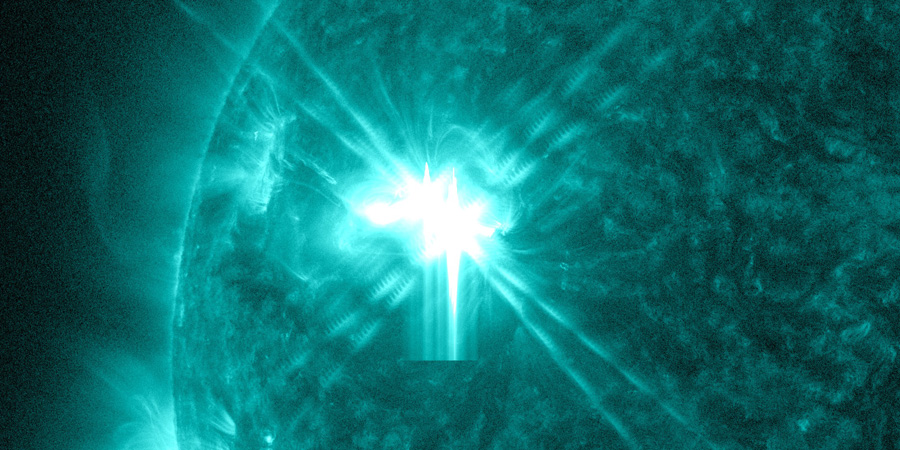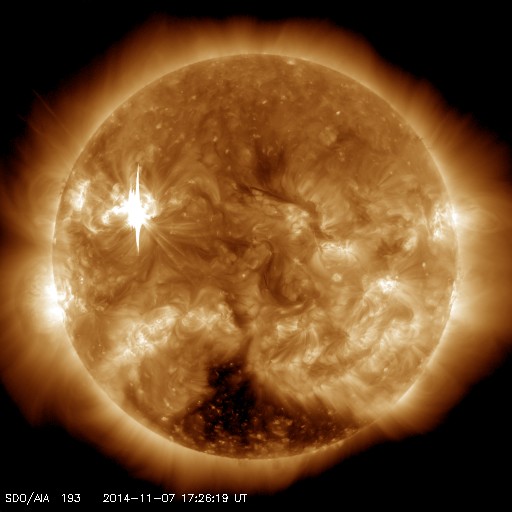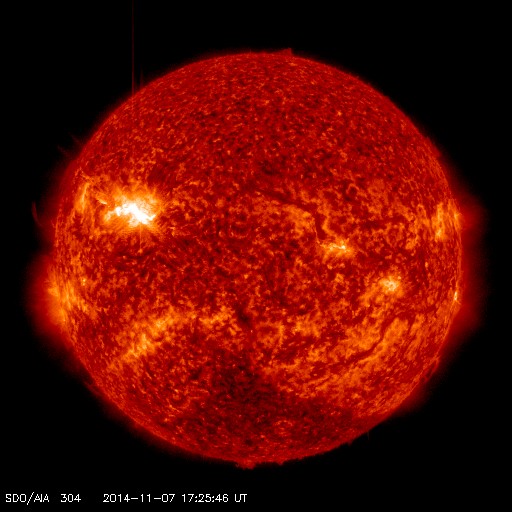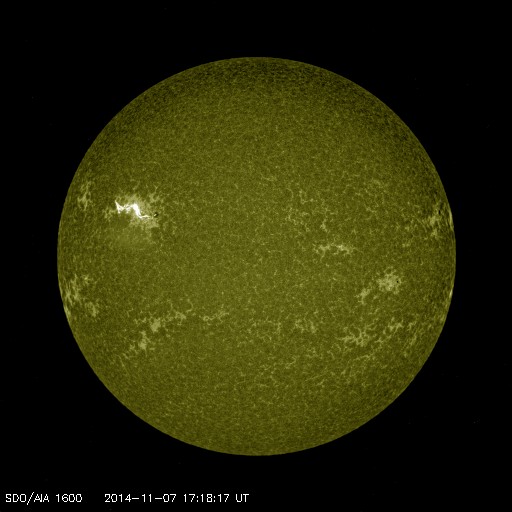X1.6 solar flare from sunspot region 2205
Friday, 7 November 2014 17:59 UTC

Sunspot region 2205 has just produced an X1.6 (R3-strong) solar flare that peaked at 17:26 UTC. It already produced numerous M-class solar flares the past few days and now we saw it's first X-class solar flare! SDO imagery suggests this solar flare is eruptive and that it likely launched a coronal mass ejection (CME) despite it being a relatively impulsive solar flare. Type II and IV radio sweeps were reported which also indicate the launch of a CME.
X1.6 solar flare as seen by SDO/AIA 193 Ångström

X1.6 solar flare as seen by SDO/AIA 304 Ångström

X1.6 solar flare as seen by SDO/AIA 1600 Ångström

It is still too early for coronagraph imagery from SOHO/LASCO to see if there was a coronal mass ejection launched by this solar flare and if it is earth-directed but SDO does give us a clue on the characteristics of this eruption. We can already see some coronal dimming and a large-scale coronal propagating front (LCPF) which are always good signs that a coronal mass ejection was launched. However, we still need to wait for SOHO imagery to be 100% sure.

We could also see an increase in the high energy protons in the coming hours possibly up to the S1 minor solar radiation storm level which would hamper HF radio communication at arctic latitudes.
Due to some unforeseen problems there were no radio blackout tweets on our Twitter channel. Our apologies.
NOAA SWPC alerts
ALERT: X-Ray Flux exceeded M5 Threshold Reached: 2014 Nov 07 1715 UTC NOAA Scale: R2 - Moderate
SUMMARY: X-ray Event exceeded X1 Begin Time: 2014 Nov 07 1653 UTC Maximum Time: 2014 Nov 07 1726 UTC End Time: 2014 Nov 07 1734 UTC X-ray Class: X1.6 Location: N15E38 NOAA Scale: R3 - Strong
ALERT: Type II Radio Emission Begin Time: 2014 Nov 07 1719 UTC Estimated Velocity: 602 km/s
ALERT: Type IV Radio Emission Begin Time: 2014 Nov 07 1735 UTC
SUMMARY: 10cm Radio Burst Begin Time: 2014 Nov 07 1749 UTC Maximum Time: 2014 Nov 07 1751 UTC End Time: 2014 Nov 07 1800 UTC Duration: 11 minutes Peak Flux: 560 sfu Latest Penticton Noon Flux: 136 sfu
Also be sure to check our other update from today where we took a look at the magnetic layout of sunspot region 2205.
First LASCO frames (ADDED 20:58 UTC)
A couple of LASCO frames are now available showing that there is indeed a coronal mass ejection associated with the X1.6 solar flare of 17:26 UTC. The coronal mass ejection looks to be heading mostly east and north from Earth but we need more frames to determine if there might be a weaker earth-directed component. We will come back with more information when possible.
Coronal mass ejection analysis (ADDED 8 NOVEMBER 2014 - 11:00 UTC)
SOHO/LASCO coronagraph imagery are now complete and show that the coronal mass ejection from the X1.6 solar flare that occurred yesterday does not have a clear earth-directed component. The bulk of the CME is heading well east of Earth. There has also not been any kind of increase on the ACE EPAM monitor which you would expect after an earth-directed eruption. However, the coronal mass ejection was fairly wide covering well over 180 degrees on LASCO with a speed of about 650km/s. The width of this coronal mass ejection could indicate that we can not exclude a shock passage late on November 10. If we do see a shock passage it would be only a minor event at most and a geomagnetic storm is not to be expected.

Images: NASA SDO, ESA/NASA SOHO and SIDC.
Thank you for reading this article! Did you have any trouble with the technical terms used in this article? Our help section is the place to be where you can find in-depth articles, a FAQ and a list with common abbreviations. Still puzzled? Just post on our forum where we will help you the best we can!
Latest news
Latest forum messages
Support SpaceWeatherLive.com!
A lot of people come to SpaceWeatherLive to follow the Sun's activity or if there is aurora to be seen, but with more traffic comes higher server costs. Consider a donation if you enjoy SpaceWeatherLive so we can keep the website online!

Space weather facts
| Last X-flare | 2025/03/28 | X1.1 |
| Last M-flare | 2025/04/01 | M2.5 |
| Last geomagnetic storm | 2025/03/27 | Kp5 (G1) |
| Spotless days | |
|---|---|
| Last spotless day | 2022/06/08 |
| Monthly mean Sunspot Number | |
|---|---|
| February 2025 | 154.6 +17.6 |
| April 2025 | 147 -7.6 |
| Last 30 days | 128.8 -21.8 |


